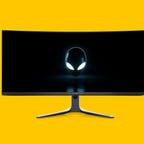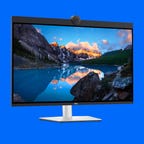
As with many categories of tech products, "best" can be subjective, regardless of how objective your testing is. For instance, I prioritize color accuracy over thin bezels and sleek curves. So I tend to refer to my top picks as "favorites" (or "top picks") rather than "bests." And while expensive monitors aren't necessarily better than cheaper ones, you usually have to spend more or make compromises, especially for more specialized displays for color work or gaming.
With that in mind, my favorite overall monitors are the , such as the Alienware 34 models and others; there are a lot more of these now. It's pricey at just under $1,000 but it has great image quality, excellent color and class-leading gaming performance. It's also widescreen, which is a perk for work.
Read more: How to Buy a Gaming Monitor
A bigger screen but for a lot less is Innocn's 40-inch 40C1R at $450. It's not nearly as good, but it's good enough all around -- especially if you can find it when the price dips.
If you need advice on whether a particular type of monitor is right for you, there are some answers to common questions at the bottom of the list and a lot more guidance available in our general monitor and gaming monitor buying guides.
The combination of OLED with Samsung's Quantum Dot color technology makes this Alienware 34-inch a standout. With great gaming performance and quality, terrific color and tonal accuracy (notably in the dark shadow areas, where OLED is weak), true HDR support, a USB hub, a solid set of controls and an above-average three-year warranty against burn-in, it really is hard to beat. It's not perfect: It doesn't have speakers, though the ones built into monitors tend to be pretty lame, and I'm not thrilled with the design of the connector layout and cable management, to mention a couple nitpicks. But it's certainly a top all-around choice.
In September 2023, Alienware announced a followup model, the AW3423DWF, which is slightly less expensive and essentially the same panel, but instead of G-Sync, it supports FreeSync Pro and VESA Adaptive-Sync, two DP connectors and one HDMI versus the opposite on the older model and 120Hz VRR when hooked up to a console. There might be some other tweaks since it loses the extra overhead of the G-Sync silicon (for instance, it supposedly can mount closer to a wall with a VESA mount).
Photo Gallery 1/1
The 40-inch flatscreen Innocn trades some excellence for value, making it a solid general-purpose monitor if you need a big 'un for less and are OK with above average, but not best-in-class, gaming or color-critical accuracy. Plus, it ships with VESA mounting hardware in the box, which is convenient if you want to mount it on a wall or an arm, and unlike a lot of "value" competitors, it has a USB-C connection with 90-watt power delivery.
Like many big-for-less displays, the Innocn has somewhat low resolution for its size -- 3,440x1,440 pixels -- but if you normally scale your view, then it should suit. Gaming is solid, but if you play games with really fast moving action, the motion artifacts may bother you. It does handle 144Hz (DP) and 100Hz (HDMI) refresh rates, though. And it has a lot of features that are either minimally effective or undocumented.
One of my pet peeves with the majority of monitors is the location of all the connectors in a hard-to-reach recess. That's not an issue if you never have to get to the USB ports or swap the video cables. But if you do, then this HP stands out for its diamond-angled back that essentially puts all the connectors on the sides. It's no slouch as a monitor either. My unit required a little tweaking to hit some better color accuracy, but was quite good afterward. And it's great for both PC and console gaming, with support for 4K at 144Hz over DisplayPort and 4K/120Hz VRR compatible with consoles. Plus it's got a USB hub.
Don't get it if you want real HDR or are swayed by the lure of speakers -- the latter are good for boop-and-beep notifications, for example, but can't replace a real speaker system or headset. And my one peeve about the design is the stand's inability to swivel.
Dell's IPS Black panel in this 32-inch monitor (plus webcam, mic and speakers) delivers the broad color gamut of IPS plus deeper blacks, which means higher contrast than usual. And that translates to easier on the eyes for long days in front of the screen.
The "videoconferencing" refers to a tilting 4K webcam, 12-watt speakers, mic array, on-bezel videoconferencing touch controls and extra work perks like power delivery and monitor daisy chaining, a ton of USB connections for docking and more. If you like your desk to look like it's a stock photo, it's a clean solution. And some of the USB ports are even within easy reach. Since most of the features are controlled in software, this isn't a good choice for Mac users.
It's expensive, but it does include the equivalent of a webcam, conference phone and hub. So if you need those, it somewhat mitigates the sticker shock. If and when it goes on sale, it will also be a good value.
Dell released firmware that it says addresses at least some of the nitpicks I had when I reviewed it -- mostly about the sound and image quality for the mic and camera -- but I was unable to go back and retest.
Read our Dell UltraSharp 32 Videoconferencing Monitor (U3223QZ) review.
Pricey but pretty -- with excellent color accuracy and reference profiles plus a good, six-speaker audio system -- the Apple Studio Display gives Mac ecosystem fans exactly what one expects from Apple.
That includes some of the downsides as well, such as no physical controls, no HDR, extra cost for a stand that lets you adjust the height (with no swivel or rotation), a single input connection and the three USB-C ports on the back rather than easily accessible.
HyperX Armada 27 ($300 for the monitor and $60 for the arm): HyperX's first foray into gaming monitors feels a little like a test balloon. Parent company HP already sells an Omen line of gaming monitors, and it seems like a monitor-plus-arm is just an attempt to differentiate. The Armada 27 is a fine 165Hz, 1440p gaming display and the arm comes with parts for multiple types of mounting, but I wasn't a huge fan of the arm design and there are better 27-inch 1440p monitors for the money.
Sony InZone M9 ($698): This PlayStation-optimized monitor -- though its not from Sony's PlayStation division -- is a great HDR experience (DisplayHDR 600 with 96-zone local dimming) and works as advertised with the PS5. If you plan to mount it on an arm or VESA-compatible stand, then bump my opinion up a few notches; over time, I've grown to dislike the stand design more and more. Plus, the InZone M9 takes forever to cycle through inputs in auto input select mode on a multimonitor/input system.
What screen size do I need?
Should I get two screens or one ultrawide?
Need more guidance? We've got more detailed info on what to look for in a general-purpose monitor and more specifically what's important in a gaming monitor.









 Add Category
Add Category
